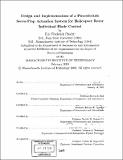| dc.contributor.advisor | Steven R. Hall. | en_US |
| dc.contributor.author | Prechtl, Eric Frederick | en_US |
| dc.contributor.other | Massachusetts Institute of Technology. Dept. of Aeronautics and Astronautics. | en_US |
| dc.date.accessioned | 2005-08-22T23:56:39Z | |
| dc.date.available | 2005-08-22T23:56:39Z | |
| dc.date.copyright | 2000 | en_US |
| dc.date.issued | 2000 | en_US |
| dc.identifier.uri | http://hdl.handle.net/1721.1/9266 | |
| dc.description | Thesis (Ph.D.)--Massachusetts Institute of Technology, Dept. of Aeronautics and Astronautics, 2000. | en_US |
| dc.description | Includes bibliographical references (p. 177-186). | en_US |
| dc.description.abstract | A novel new actuator for helicopter rotor control, the X-Frame Actuator, was developed, demonstrating superior performance for applications requiring compact, fast acting, large stroke actuation. The detailed experimental characterization of this actuator is described, including bench-top output energy measurements and transverse shake test performance. A Mach scaled rotor blade utilizing the X-Frame actuator to power a trailing edge servo-flap near the tip was also designed, manufactured and tested. A description of the design and composite manufacturing of the rotor blade and servo-flap is presented. Preliminary bench tests of the active blade actuation system are also presented. The hover tests of the active blade provided transfer function identification of the performance of the actuator in producing flap deflections, and the response of the rotor from deflections of the servo-flap. At the highest field level of 60 V/mil P-P the actuation system produces 7.75 degrees of quasi-static peak-to-peak flap deflection in hover. The servo-flap produces significant control authority, especially near the 3/rev frequency that would be important for the CH-47. Scaled to a full-sized CH-47, the rotor can produce over 16,000 lb peak-to-peak thrust variation at 3/rev, which is 32% of the aircraft's gross weight. Closed-loop feedback control was experimentally applied to the model rotor system. Both single frequency and combined frequency controllers were successfully implemented on the rotor. Most significantly, simultaneous control of 1/rev, 3/rev, 4/rev, 5/rev, and 6/rev harmonic vibration has been successfully demonstrated. The peak vibrations were eliminated at each frequency, as well as the vibrations over a small bandwidth surrounding each peak. Experimental comparison of continuous time versus discrete time control has shown the former to be a more effective approach for vibration reduction. | en_US |
| dc.description.statementofresponsibility | by Eric Blade Prechtl. | en_US |
| dc.format.extent | 371 p. | en_US |
| dc.format.extent | 29420624 bytes | |
| dc.format.extent | 29420381 bytes | |
| dc.format.mimetype | application/pdf | |
| dc.format.mimetype | application/pdf | |
| dc.language.iso | eng | en_US |
| dc.publisher | Massachusetts Institute of Technology | en_US |
| dc.rights | M.I.T. theses are protected by copyright. They may be viewed from this source for any purpose, but reproduction or distribution in any format is prohibited without written permission. See provided URL for inquiries about permission. | en_US |
| dc.rights.uri | http://dspace.mit.edu/handle/1721.1/7582 | |
| dc.subject | Aeronautics and Astronautics. | en_US |
| dc.title | Design and implementation of a piezoelectric servo-flap actuation system for helicopter rotor individual blade control | en_US |
| dc.title.alternative | Piezoelectric servo-flap actuation system for helicopter rotor individual blade control | en_US |
| dc.type | Thesis | en_US |
| dc.description.degree | Ph.D. | en_US |
| dc.contributor.department | Massachusetts Institute of Technology. Department of Aeronautics and Astronautics | |
| dc.identifier.oclc | 45613255 | en_US |

